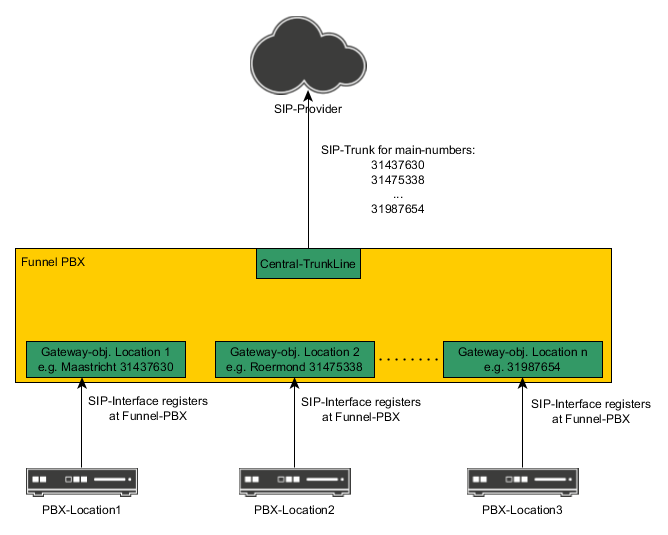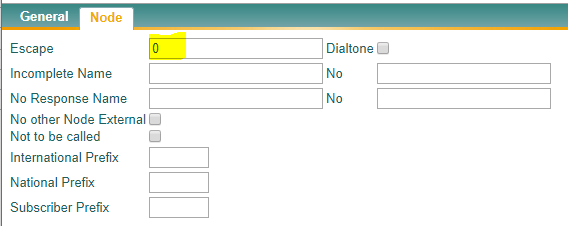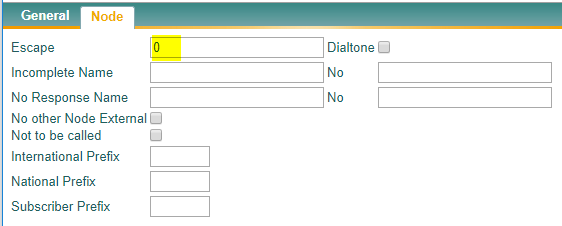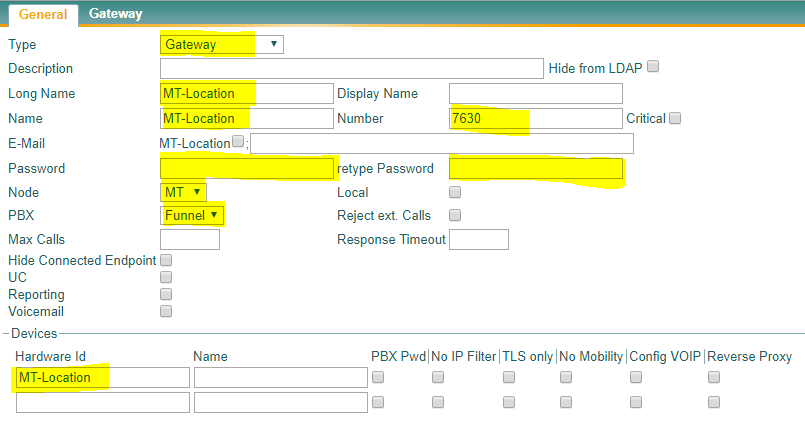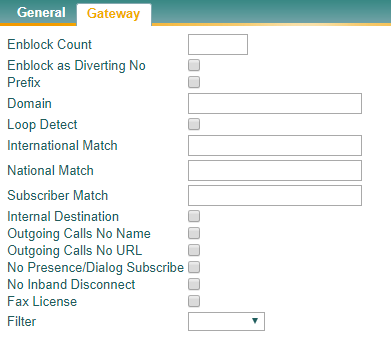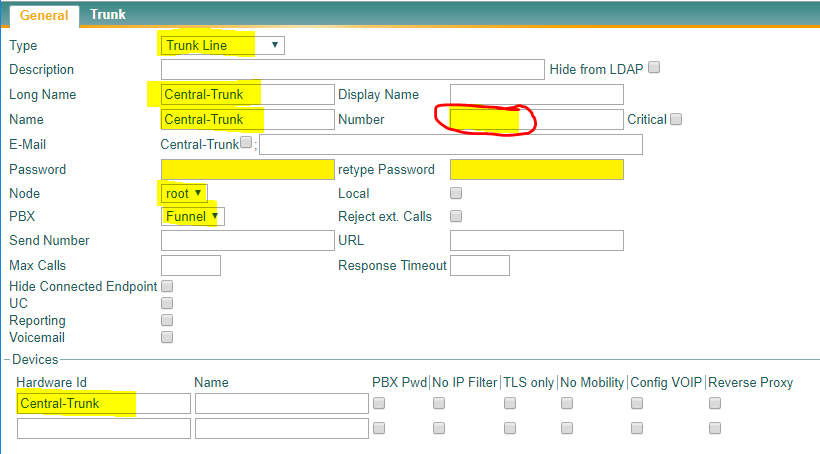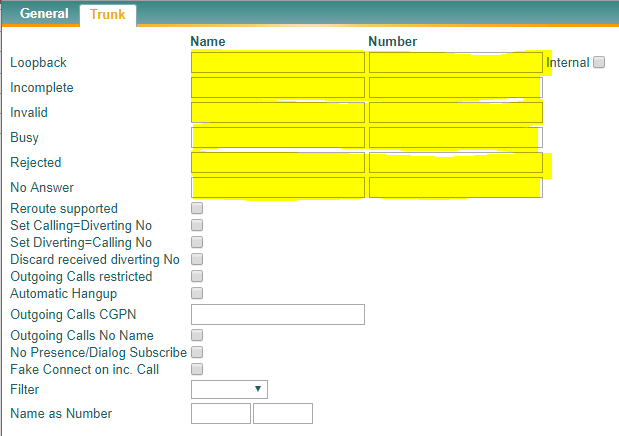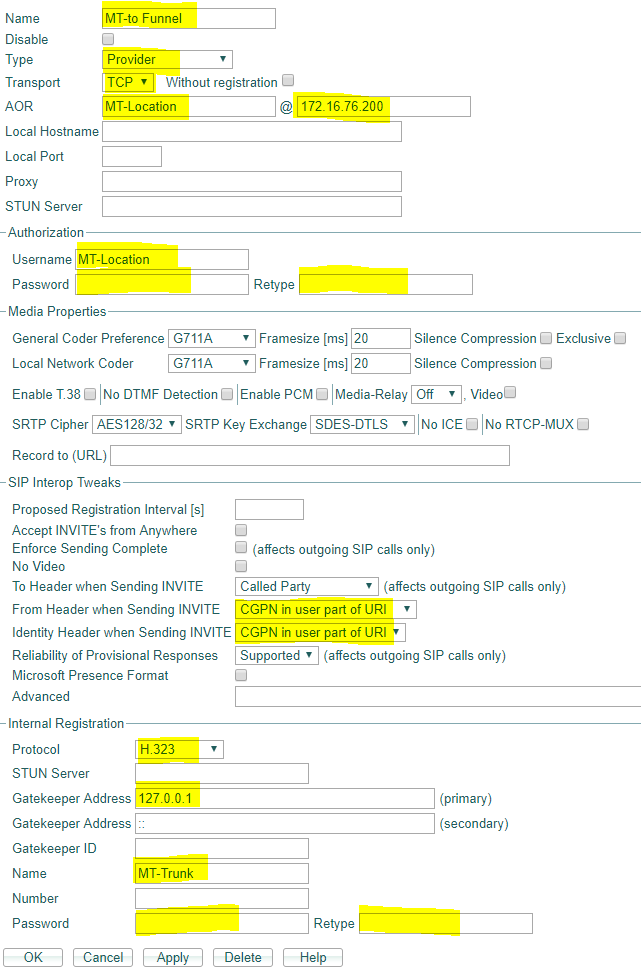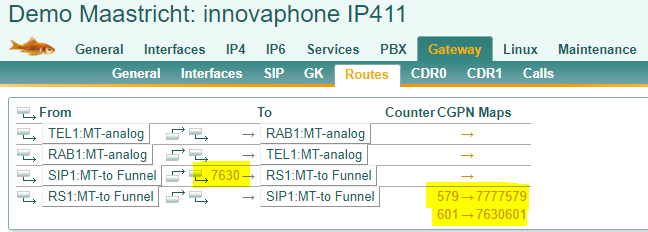Howto12r2:Central SIP trunk with multiple subscriber numbers: Difference between revisions
| Line 90: | Line 90: | ||
'''If Configured OK the registration is | '''If Configured OK the registration is visible on both sides, the Location PBX and the Funnel-PBX.''' | ||
[[Image:MT-Location Gateway SIP Trunk registration.PNG]] | [[Image:MT-Location Gateway SIP Trunk registration.PNG]] | ||
| Line 96: | Line 96: | ||
[[Image:Funnel PBX Registrations.PNG]] | [[Image:Funnel PBX Registrations.PNG]] | ||
To route the | To route the incoming calls correctly to the Called Party Number CDPN and present the correct Calling Party Number CGPN with outgoing calls, we have to create some changes in the Routes of the Local PBX. | ||
Revision as of 12:23, 29 November 2017
Applies To
This information applies to
V12r2 sr6 Build 12.5236 and later.
This document is still under construction! --Kpe 20:21, 21 November 2017 (CET)
More Information
In this scenario every customer site is an innovaphone Gateway/PBX providing PBX functionality (or PBX with Gateway functionality with ISDN PRI BRI or SIP Trunk to a legacy PBX on a location).
In stead of having a ISDN or SIP Trunk to the PSTN network on every location, there will be a Central big sip trunk on one location that provides the PSTN access for all other locations.
The call routing is done by an innovaphone PBX containing a node tree with appropriate placed Gateways for each customer location.
Overview
The following diagram shows a simple scenario of a Funnel PBX with N locations providing a central big sip trunk for all sub-locations.
The sub-locations providing PBX functionality for the location. (and can also provide the gateway-functionality to a legacy PBX for a migrations scenario).
Configuration of the Funnel PBX
Start with configurating of your Funnel PBX with the following Objects:
- Node Objects with the Country Code, in this example the Node Objects for NL (Netherlands) with country code 31.
- Node Objects with the location and prefix of the location, in this example the Node Objects for the locations Roermond (RM) and Maastricht (MT).
- Gateway Objects with the prefix for the PBX-locations, so that the PBX/Gateway on that location can register against this opbject via SIP.
- Number Map Objects for the locations, in case you don't have a closed DID range but one or more MSN numbers, you can create these as a Number Map Object and route the call to the desired number or object within a location.
- Trunk Line Object in the Funnel-PBX, the central trunk line object that register at the big sip trunk and an internal registration to the Funnel-PBX.
Although that in some examples the password field is left blank, you should consider security and cofigure safe passwords for all objects !
Funnel-PBX Objects
Create the Funnel PBX Objects like in this example NL with country code 31
Node Object General
Create the Node Object with the country code
Node Object General
Create the Node Object for the locations like in this example MT with area code 43
Gateway Object General
Create the Gateway Object for the PBX/Gateway in the location. In this example with PBX prefix 7630.
Repeat these steps for all the locations in your scenario.
Trunk Line Object
Create a Trunk Line Object Central-Trunk. The number field in the Trunk Line Object is left blank by purpose. The reason is to avoid this number to be displayed in your telephone set after the connection has been established (Connected Number).
Choose some reasonable destinations for Loopback, Incomplete, Invalid, Busy, Rejected and No Answer. For example the Operators destination number in the HeadOffice.
Configuration of a location PBX-Gateway
The PBX in the locations can be a Single Master PBX, a slave PBX or slave PBX that is part of an e164 Large PBX configuration.
The type of PBX doesn't matter for the registration to the Funnel-PBX.
The registration to the Funnel PBX is done via a SIP trunk registration to the Gateway Object in the Funnel-PBX.
The Configuration of the SIP trunk is shown in the picture.
If Configured OK the registration is visible on both sides, the Location PBX and the Funnel-PBX.
To route the incoming calls correctly to the Called Party Number CDPN and present the correct Calling Party Number CGPN with outgoing calls, we have to create some changes in the Routes of the Local PBX.
In the Maastricht location we use as single MSN number 31 43 7777 579. Because this number is not part of the DID range 7630 xxx, we have to create a single number map to the desired destination, preferable a number in the original DID range.
System Requirements
You can use either IPVA's or our Hardware devices to setup the complete scenario. For the Funnel-PBX you will probably use an IPVA or an IP0011 because you don't need any Fysical Hardware interfaces like PRI or BRI.
In the Sub-locations it depends on your needs, the amount of users and the Fysycal interfaces like analog ports or BRI/PRI for integrating with a legacy PBX.
Licenses
What kind of licenses do you need and how many ?
Funnel-PBX.
In the Funnel_PBX you need only Port-licenses. The amount depends on your needs. You need at least 1 Port lic. for the internal registration of the Central-Trunk to your SIP Provider. Further you need 1 Port lic. for every sub-location that registers on the Gateway Object of that PBX Location.
Location-PBX.
How many and what kind of licenses you need in the Location-PBX, is depending on the scenario and the customer needs.
The posible scenarios are:
- you have standalone PBX on the locations, you need the licenses in your Location-PBX and you need the appropiate Interface licenses (BRI,PRI,TEL)
- you have a Master-Slave scenario, you need all the Port licenses in your Master PBX and the appropiate Interface licenses (BRI,PRI,TEL) in your Location-PBX
You need at least 1 Port lic. for the Trunk-Line Object of the Location-PBX.
Just in case you have a trunk to a Legacy-PBX, you will need a Port lic for that trunk as well.
Depending on the customer needs you will have to add the Port lic per User Object and if desired also the UC-licenses per User Object.
For example:
You have 65 Sub-locations (with a Legacy-PBX) and 1 Headquarter (with a Legacy-PBX).
IPVA Funnel-PBX:
1 Port lic. Central-Trunk to SIP provider
1 Port lic. per location for (Registered Gateway Object)
N locations = 66 (HQ + 65 sub-locations)
Total amount of Port lic in the Funnel-PBX = 67 Port lic.
IPVA Master PBX and Slave locations:
1 Port lic. per location Trunk-line (0)
1 Port lic. per location for the trunk to the Legacy-PBX(SIP or ISDN)
N Locations = 66 (HQ + 65 sub-locations)
Total amount of Port lic. in the Master-PBX = 2 x 66 = 132 Port lic.
Extra Licenses recommended or needed:
x Port lic. for Users with IP-Phones or for analog ports on location(s)
x UC licenses for users
The total amount of hardware licenses is depending on the Location-PBX, used device and used Interface(s). In a IP411 and IP311 the hardware licenses are already included, for a IP811 and IP3011 you need to add the approiate amount of hardware licenses and relay-channel licenses.
